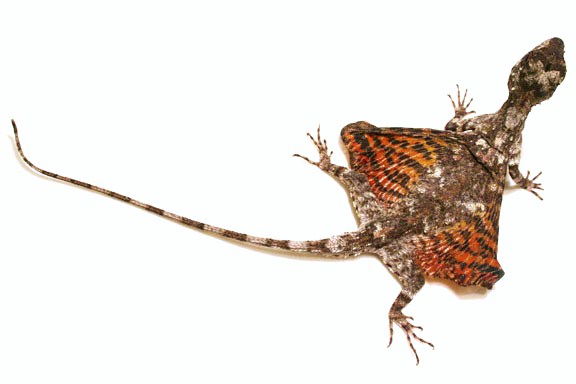Scientific classification: Flying dragons are members of the family Agamidae, in the order Squamata. They make up the genus Draco.
Introduction
Draco is a genus of agamid lizards that also are known as flying dragons. The ribs and their connecting membrane may be extended to create a wing, the hindlimbs are flattened and wing-like in cross-section, and a small set of flaps on the neck serve as a horizontal stabilizers, flying dragon lizard. Draco are arboreal insectivores. While not capable of powered flight they often obtain lift in the course of their gliding flights. Glides as long as 60 m (200 ft) have been recorded, over which the animal loses only 10 m (33 ft) in height, which is quite some distance, considering that one of these lizards is only around 20 cm (7.9 in) in total length (tail included).
Flying Dragon, also known as draco and flying lizard, common name for any of a group of tropical tree lizards capable of gliding through the air. Flying dragons are native to Southeast Asian forests, the East Indies, and the Philippines. They are typically 10 to 15 cm (4 to 6 in) long and feed primarily on insects.
Description
The flying dragon cannot actually fly but can glide considerable distances. Along each side of the body are winglike membranes formed by a thick fold of skin supported by elongated ribs. At rest, the flying dragon folds the membranes against its body. On a tree trunk, it may press the membranes close to the bark to conceal its shadow. When the flying dragon wants to glide, flying dragon lizard it faces downward on a tree, spreads its winglike membranes, and pushes away from the tree with its feet. It can fly directly from tree to tree and spends little time on the ground. The flying dragon’s colorful membranes are also used to attract females during courtship.
Reproduction
The only time a flying lizard ventures to the ground is when a female is ready to lay her eggs. She descends the tree she is on and makes a nest hole by forcing her head into the soil. She then lays 2–5 eggs before filling the hole. She guards the eggs for approximately 24 hours, but then leaves and has nothing more to do with her offspring, flying dragon lizard. The lizards are well known for their “display structures” and ability to glide long distances using their wing-like, patagial membranes supported by elongated thoracic ribs to generate lift forces.

